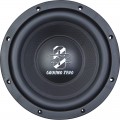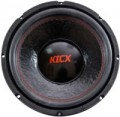Design
—
In the body. Subwoofers consisting of a full-fledged enclosure in which the speaker (speakers) is installed. Usually they are designed to be installed in the boot. Cabinet models are easy to install, but take up a significant amount of space, and in most cases have some phase delay that requires phase adjustment (see below) to synchronize with the front speakers.
—
Without body. This category includes subwoofers designed to work in their own cabinet, but not equipped with it (not to be confused with Free Air — see below). Thus, having bought such a speaker, you can choose a case for it at your discretion — or even make it yourself. This, of course, is more difficult than immediately acquiring a cabinet “subwoofer”, however, it gives more opportunities for adjusting the acoustics to personal preferences. Other advantages and disadvantages of frameless models are similar to case models.
—
Without body (Free Air). Car subwoofers of this type are not only not equipped with a case, but they do not imply its use at all: usually Free Air models are designed for installation in the rear shelf or back of the rear seat, and the boot plays the role of the case. The advantages of such an installation are the minimum space occupied (which is important with small boot volumes), as well as the almost complete absence of delay and the ease of “docking” with the main c
...hannels of the audio system. On the other hand, installing a Free Air subwoofer in itself is associated with a number of difficulties. For example, for the effective operation of such a speaker, the boot must be hermetically separated from the passenger compartment; it is quite difficult to provide such conditions, and in some body types (for example, station wagons) it is almost impossible. In addition, such a speaker has much less ability to adjust to a specific interior than a cabinet one; and with a tightly loaded boot, the sound characteristics deteriorate noticeably. Therefore, paying attention to such “subs” is primarily for owners of sedans who do not have to carry a lot of luggage.Size
The size (diameter) of the main subwoofer speaker. In all types of subwoofers, this parameter primarily affects the power and depth of sound: the larger the speaker, the louder it is and the deeper the bass it can provide (ceteris paribus). However with an increase in the size and dimensions, they increase accordingly, which determines the installation possibilities. The latter is especially true in Free Air subwoofers (see "Execution"): some cars are initially equipped with "seats" for a certain size, and it is difficult to install models with other dimensions there.
Now on the market there are subwoofers with such popular sizes:
5" (13 cm),
6" (15.25 cm),
6.3" (16 cm),
6.5" (16.5 cm),
6.75" (17 cm),
8" (20 cm ),
8.25"(21cm) , 9" (23cm
), 10" (25cm
),
11" (27cm),
12"(30cm) ,
13" (33cm),
15"(38cm) ,
16 " (40 cm),
18" (46 cm).
Rated power
The average (root mean square — RMS) power of the input signal, at which the subwoofer is able to work continuously without negative consequences (damage, failure) for at least an hour. The rated power of the subwoofer must be greater than the power of the amplifier connected to it — in order to avoid overloads.
Max. power
The maximum signal power that the subwoofer is able to withstand for a short time (up to several seconds) without any negative consequences. When selecting an amplifier-subwoofer pair, it is recommended to take a subwoofer with a maximum power of at least twice the maximum power of the amplifier. In general, the higher the maximum power, the more resistant the subwoofer is to overloads.
Sensitivity
Sensitivity determines the loudness of the subwoofer when a signal of a certain power is connected to it: with equal signal power and impedance (see below), the subwoofer with the higher sensitivity will sound louder.
Dual voice coil
A dual voice coil is actually two separate voice coils on the same speaker. This allows you to connect two amplifiers to the subwoofer at once, thus providing high sound power.
Impedance
The electrical resistance of a subwoofer when a signal is applied to it. This parameter is important primarily for selecting a subwoofer-amplifier pair: at a lower impedance than that of the amplifier, the subwoofer will distort the sound, at a higher impedance the sound will be too quiet.
For dual voice coil models (see above), the impedance is specified for one of the voice coils.
Resonant frequency
The natural frequency of the cone in the subwoofer speaker, namely the frequency with which the cone will oscillate if the speaker is suspended freely in the air and a single impulse is transmitted to the cone (for example, by clicking on it with your finger). In subwoofers, this parameter determines, in particular, the lower limit of the frequency range (see above): at frequencies below the resonant sound power drops sharply. Accordingly, for deep rich bass, the resonant frequency should be as low as possible. This parameter is also used to calculate the size of the enclosure for the subwoofer.
Diffuser material
The material from which the speaker cone in the subwoofer is made. Determines the sound quality and, to some extent, the cost of the device.
— Pulp/paper. Historically the first diffuser material. Its advantages are lightness (which ensures high speaker sensitivity), as well as a smooth frequency response (amplitude-frequency response), which positively affects the sound quality. Among the shortcomings — low strength, which limits the power of such subwoofers, as well as softness, somewhat "blurring" the sound in difficult moments. In addition, paper diffusers are sensitive to moisture.
— Polypropylene. Synthetic polymer, in some aspects similar to paper, but differing from it in higher strength and resistance to moisture. It also has a smooth frequency response. Somewhat more cruel, but still belongs to the soft.
— Polyurethane. Another polymer material. At a low cost, it is somewhat stiffer than polypropylene, and is also very resistant to mechanical stress, which allows you to create powerful speakers.
— Kevlar. Kevlar fibre is highly durable (higher than steel); it also has good rigidity, which has a positive effect on fidelity in difficult moments. However, such diffusers are not cheap.
— Carbon fibre. It belongs to premium materials: it has high strength at a very low weight, and in the case of subwoofers, it is also worth mentioning the good rigidity that ensures a clear sound. Among the shortcomings — a somew...hat uneven frequency response and an impressive cost.
— Carbon. Another name used for carbon fibre is mainly for promotional purposes, for brevity and “impressiveness” of sound. See above for more details on carbon fibre.
— Fibreglass. Such material consists of ordinary glass stretched into filaments; unlike the classical form of glass, such threads do not break or break. It's lightweight (respectively sensitive), relatively cheap, resistant to moisture and temperature changes, and still provides good (though not outstanding) sound quality.
— Composite materials. Composite is a material that consists of two or more materials with a clear separation between them. In subwoofer cones, carbon fibre composites (based on carbon fibre, see above) are most often used. Such diffusers have all the advantages of carbon fibre and are able to provide good sound quality — however, due to the characteristics of the frequency response of the material, rather complex electronic circuits have to be used to achieve this quality, which affects, in particular, the price of subwoofers.
— Aluminium. Aluminium cones have the highest rigidity of all, which ensures high fidelity of sound transmission even in difficult moments. The "reverse side of the coin" in this case are their own extraneous "ringing" that occurs in the diffuser. To eliminate them, you have to use various tricks that significantly complicate the design and increase the price of the subwoofer.
Note that each material has its own characteristics and shades of sound, which you should pay attention to when choosing — a more expensive and high-quality material will not necessarily give a sound that you personally will like more.

